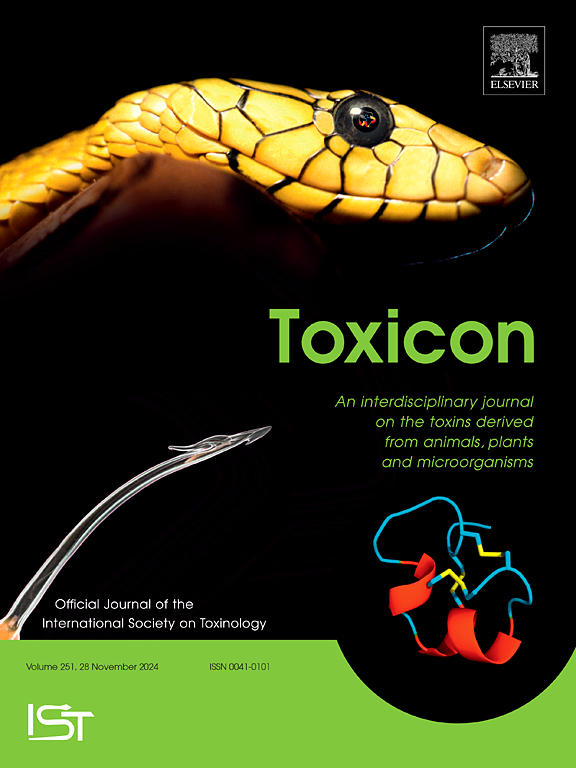Deoxynivalenol induces pyroptosis and IL-1β secretion via P2X7R signal in murine RAW264.7 macrophages
IF 2.6
4区 医学
Q2 PHARMACOLOGY & PHARMACY
引用次数: 0
Abstract
Deoxynivalenol (DON), a trichothecene mycotoxin, exerts pro-inflammatory and immunomodulatory activity. Interleukin (IL)-1β serves a crucial part as a gate keeper of inflammation in DON-induced macrophages, but an overview of how DON exposure elicits IL-1β secretion from RAW264.7 cells has not been fully illustrated. Here we found that the cellular phenomenon, involved with a type of programmed cell death known as pyroptosis, contains: 1) increase of pro-IL-1β expression, 2) motivation of caspase-1, 3) caspase-1-dependent maturement of IL-1β, 4) caspase-1 fragmentation of gasdermin D (GSDMD), and 5) IL-1β secretion through GSDMD pore. Mechanistically, the present study certified that DON both as first and second signals engaged in IL-1β release is mediated by purinergic P2X7 receptor (P2X7R)-Src signaling. During this process, P2X7R signal is required for GSDMD pore forming course in ASC-independent manner. Moreover, blocking of K+ efflux, ROS formation, as well as cathepsin B activity decreases IL-1β export. Our data show that exposure to DON does cause pyroptosis and IL-1β secretion via P2X7R signal in RAW264.7 macrophages. Overall, these results provide new mechanistic clue for DON as a pro-inflammatory factor in innate immune signaling events.
脱氧雪腐酚醇通过P2X7R信号诱导小鼠RAW264.7巨噬细胞焦亡和IL-1β分泌
脱氧雪腐镰刀菌烯醇(DON)是一种霉菌毒素,具有促炎和免疫调节活性。白细胞介素(IL)-1β在DON诱导的巨噬细胞炎症中起着至关重要的作用,但DON暴露如何诱导RAW264.7细胞分泌IL-1β的概述尚未得到充分说明。在这里,我们发现与一种被称为焦亡的程序性细胞死亡有关的细胞现象包括:1)pro-IL-1β表达增加,2)caspase-1的动机,3)caspase-1依赖性IL-1β成熟,4)caspase-1裂解气皮蛋白D (GSDMD),以及5)通过GSDMD孔分泌IL-1β。在机制上,本研究证实DON作为参与IL-1β释放的第一和第二信号是通过嘌呤能P2X7受体(P2X7R)-Src信号传导介导的。在此过程中,GSDMD成孔过程需要P2X7R信号,且与asc无关。此外,阻断K+外排、ROS形成以及组织蛋白酶B活性可减少IL-1β的输出。我们的数据表明,暴露于DON确实会引起RAW264.7巨噬细胞的焦亡和通过P2X7R信号分泌IL-1β。总之,这些结果为DON在先天免疫信号事件中作为促炎因子提供了新的机制线索。
本文章由计算机程序翻译,如有差异,请以英文原文为准。
求助全文
约1分钟内获得全文
求助全文
来源期刊

Toxicon
医学-毒理学
CiteScore
4.80
自引率
10.70%
发文量
358
审稿时长
68 days
期刊介绍:
Toxicon has an open access mirror Toxicon: X, sharing the same aims and scope, editorial team, submission system and rigorous peer review. An introductory offer Toxicon: X - full waiver of the Open Access fee.
Toxicon''s "aims and scope" are to publish:
-articles containing the results of original research on problems related to toxins derived from animals, plants and microorganisms
-papers on novel findings related to the chemical, pharmacological, toxicological, and immunological properties of natural toxins
-molecular biological studies of toxins and other genes from poisonous and venomous organisms that advance understanding of the role or function of toxins
-clinical observations on poisoning and envenoming where a new therapeutic principle has been proposed or a decidedly superior clinical result has been obtained.
-material on the use of toxins as tools in studying biological processes and material on subjects related to venom and antivenom problems.
-articles on the translational application of toxins, for example as drugs and insecticides
-epidemiological studies on envenoming or poisoning, so long as they highlight a previously unrecognised medical problem or provide insight into the prevention or medical treatment of envenoming or poisoning. Retrospective surveys of hospital records, especially those lacking species identification, will not be considered for publication. Properly designed prospective community-based surveys are strongly encouraged.
-articles describing well-known activities of venoms, such as antibacterial, anticancer, and analgesic activities of arachnid venoms, without any attempt to define the mechanism of action or purify the active component, will not be considered for publication in Toxicon.
-review articles on problems related to toxinology.
To encourage the exchange of ideas, sections of the journal may be devoted to Short Communications, Letters to the Editor and activities of the affiliated societies.
 求助内容:
求助内容: 应助结果提醒方式:
应助结果提醒方式:


